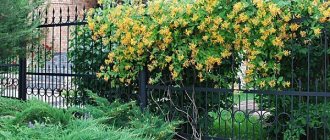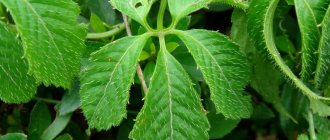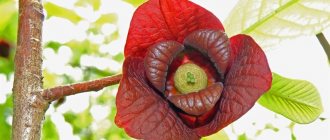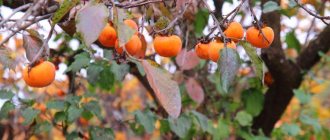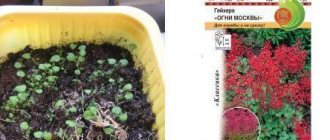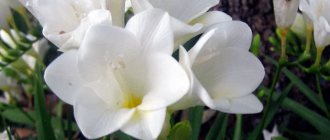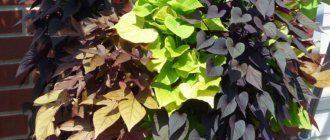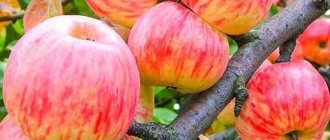Perennial vines allow you to combine architectural elements and plant material in landscape design.
They seem to cover walls, arches, gazebos and outbuildings with a thick carpet.
Redweed or tree-nose is a vigorous vine that quickly takes over the garden.
It is valued not only for its unpretentiousness, but also for its decorative fruits. Red juicy boxes look elegant against the background of yellow doors.
Types and varieties of wood pliers plants with photos
A liana from the euonymus family grows in Asia, Australia and America. There are 30 species in total, 3 of which can be found in the Far East.
Wood pliers grow on the edges of forests, at the foot of slopes and in river valleys. The plant received its unusual name for its ability to tightly twine around trees, leading to their death.
The liana firmly wraps itself around the support, clinging to it with its buds.
A photo of a tree plier from the Internet shows that it is most often used to decorate the walls of buildings, fences, pergolas and gazebos.
The plant reaches a height of 18 m, the annual growth in the first years is 1 m. Without support, it spreads along the ground and forms a thick carpet.
The most popular variety is the round-leaved tree plier.
Under natural conditions, it grows in the Khabarovsk Territory, Primorsky Territory, Sakhalin, China and Japan.
The vigorous vine has brown bark and dark green leaves that turn orange in the fall.
The flowering period occurs in June, the inflorescences are inexpressive.
The fruits are orange-yellow in color. Under favorable conditions, they stay on the vine until spring.
Celastrus orbiculatus is the most winter-hardy species. In the middle zone you can do without shelter for the winter.
Wood pliers
Common species include the wood pliers.
The ten-meter vine is covered with green oval leaves. White semi-umbrellas of flowers appear in late spring.
Shoots of this species take root easily. If you do not pay attention to plantings, they will quickly turn into dense thickets.
In the fall, the whip-shaped tree pliers are covered with yellow capsule fruits. The seeds have a red tint.
Less common is the corymbose red bladder, which is native to Sakhalin and Japan. This variety is distinguished by lentils on its shoots.
The foliage is large and has a bright green tint. The plant blooms in mid-summer, the inflorescences are inconspicuous. The seedlings are colored red-orange.
Climbing tree pliers
In the western regions, a species of liana native to the USA and Canada is widely cultivated. The climbing tree pliers has long occupied a niche in landscape design.
It grows poorly in the horizontal direction, and on a support it can reach a height of seven meters.
The green leaves of celastrus scandens turn yellow in autumn. Small flowers bloom in early summer.
When the orange fruits open, the red ovary is visible. The climbing tree pliers retain fruits on the branches until December. The species is in demand for its frost resistance and rapid growth.
Based on these species, new varieties were developed.
The most popular of them:
- round-leaved wood plier "Hercules". Japanese large-leaved variety that gives great growth.
Undemanding to soil quality. The height of the vine is 12 m, the fruits are yellow-orange. Green foliage turns yellow in autumn. The variety is resistant to pests and diseases;
- round-leaved tree plier "Diana". The height of the plant is 12 m.
Grows well both in light areas and in the shade. The rounded leaves create a lush mass. By autumn they turn bright yellow.
Yellow-red fruits appear in early autumn, fruiting is abundant. Wood pliers "Diana" are often used to decorate garden plots.
The annual growth is 1 m. In horizontal plantings it quickly forms thickets.
Celastrus orbiculatus diana should not be planted next to trees, as the vine can choke them. The variety is ideal for decorating fences and ugly buildings;
- round-leaved wood plier “Duo”. In sunny areas it can grow up to 50 m. Hard buds firmly grip the surface. Oval foliage changes color in autumn;
- Woodplier “A True Gentleman.” The height of the vine is 10 m, the foliage is dark green. The orange fruits with red seedlings do not fall until spring. The variety is practically not affected by pests.
All vines wrap around the support counterclockwise. They tolerate air pollution, exhaust and soot well, so they are often used in urban landscaping.
Botanical description
Tree pliers (lat. Celastrus) is a fast-growing deciduous (less often evergreen) vine of the Euonymus family.
Powerful woody shoots up to 10 cm thick and about 50 m long climb up a vertical support to a height of up to 12 m. The annual growth is about 1 m. Shrub forms are also found. The stems are sparsely leafy, but numerous short shoots are densely covered with leaves. The stems have dark bark with deep longitudinal cracks, young shoots are covered with thin bark - at first it is green, over time it acquires an orange-red or brownish-brown tint.
The leaf blades are dense, obovate-shaped with a pointed apex, length and width are 5-10 cm, the color is bright green (the leaves turn yellow in autumn).
If there is support, the vine climbs along it, and a wide (about 3 m in diameter) branched crown is formed at the top. Without support, the shoots will spread freely along the ground, creating dense thickets.
Wood plier planting technology
Redweed is an unpretentious plant.
It grows in a variety of soils, garden soil is best.
All parts of the plant are poisonous to humans; hands must be washed after work.
Children should be explained that brightly colored fruits are inedible and dangerous.
Choosing a landing site
The liana grows more intensively in open areas. Shaded areas will affect both growth rate and foliage color.
It is advisable to plant wood pliers near gazebos or fences.
In open spaces, a strong support is built for the seedling.
The soil
The best option would be fertile, slightly acidic or neutral soil.
Before planting, compost is added to the holes. The root system does not require drainage.
Time
Two-year-old seedlings take root well both in spring and autumn. At the beginning of the season, work is carried out until the buds open.
In the fall, you need to have time to plant plants before the onset of severe frosts.
How to plant
The depth of the planting hole should be slightly greater than the root system itself.
Its width is 50 cm. The roots are carefully buried, leaving the root collar above the surface.
When planting in groups, the distance between plants is 1 m.
How to remove the round-leaved tree pliers from the site
If you want to remove the round-leaved tree pliers from the site, then first the shoots themselves are cut off, then they are removed from the support. After this, the rhizome is dug up. The root system of the vine is quite powerful and, as a rule, goes deep into the soil. Therefore, at this stage some difficulties may arise. If you cannot completely uproot the plant, you can use special preparations that will burn out the remaining roots. Such chemicals are sold in garden departments.
Round-leaved tree pliers: video
Red bladder propagation
Most ornamental vines, including wood pliers, reproduce well.
Regardless of the method of propagation, young plants should be transplanted to a permanent place only after two years.
Seeds
Freshly collected material is cleared of seedlings and immediately sent to open ground.
Planting in autumn avoids long-term stratification of seeds.
They are buried 2 cm. Shoots appear in the spring; in the first seasons they need shelter and watering.
Vegetative propagation of wood pliers
Root cuttings are suitable for work: flexible shoots cut at ground level. They are harvested in the first half of summer.
Before planting, the cuttings are immersed in a solution of a growth stimulator for a day. Then they are sent to open ground.
Basic care consists of regular watering and shelter from the cold.
After 2 years, the plants are transplanted to a permanent place with a lump of earth.
Growing wood pliers from seeds
Seeds are planted in open ground either in late autumn or spring. Sowing in winter is considered the most suitable, since during the winter the seeds will undergo so-called natural selection. In the spring, only the best seeds will sprout, and the seedlings will be strong and strong. Spring planting should be done in April, but in this case, seed treatment is necessary before planting.
3 months before planting, you need to place the tree pliers seeds in the refrigerator. And after 2 months, take it out, mix it well with sand and store it in a warm place. When the seeds are ready, they can be planted in well-dug soil. After planting, you should water the soil abundantly and then the first shoots will appear in about a month.
When does tree pliers bloom and bear fruit?
During flowering, the tree pliers do not attract much attention. White panicles bloom no later than mid-June. They have a subtle aroma.
Flowering lasts no more than a week. During leaf fall, the spherical fruit boxes turn bright colors.
They open with three valves, and inside there are bright appendages.
The fruits of most varieties persist throughout the winter, despite the fact that the vine itself is deciduous.
Wood plier care
Planting and caring for wood pliers in the garden is no different from other ornamental perennials. The main attention is paid to weeding and periodic watering.
After removing the weeds, the tree trunk circles are loosened. Mulch will reduce gardening work, it will retain moisture in the ground and prevent grass from growing.
Fertilizing is applied twice per season.
It is better to use a complex granular preparation, for example “Kemira-Universal” or “Omu”.
In early spring, sanitary pruning of shoots is carried out. Planting and caring for Diana tree pliers, as well as other varieties, is exactly the same.
Pruning and feeding
Pruning work begins in February, before the sap begins to flow. During this period, one sanitary pruning is carried out, during which weak, rotten or damaged shoots are removed. During the growing season, pruning is possible to form a bush or thin out a dense crown.
Experienced gardeners recommend cutting individual shoots to the ground, because in one year they will grow back up to one meter.
Another important point in caring for lianas is prevention of root freezing , which is carried out by mulching the soil with peat. Due to its good frost resistance, wood pliers do not need to provide shelter for the winter.
During the warm period in spring and summer, the required amount of dry complex fertilizers is poured under the vine. They need to be placed to a depth of 15 centimeters, after which the soil is thoroughly watered. With the arrival of autumn, you can feed the plant with compounds based on potassium and phosphorus.
If we talk about diseases and pests, then the tree pliers are practically not afraid of them. The culture has a fairly developed immune system, which helps it fight all kinds of misfortunes and maintain its incredible attractiveness.
Application in landscape design
Most species and varieties are used in landscaping buildings and decorative structures.
The tree plier will quickly braid pergolas, arches, and trellises. It will protect gazebos and benches from bright light and turn the fence into a real hedge.
The wattle species strengthens slopes, ravines and the banks of artificial reservoirs well.
You should not use vines in compositions. It will twine and choke low-growing bushes and young trees.
Tree pliers in the garden
Wood pliers serve as a wonderful garden decoration. Its thick emerald crown will hide a fence or part of outbuildings, and will also add greenery to any vertical support. In autumn, the leaves will change color to golden-orange and will continue to delight the household. It is not necessary to point the vine upward. Tree pliers can serve as a good ground cover plant and will decorate hillsides, high banks of ponds and rivers. Also, its roots strengthen the soil and prevent landslides. In a flower garden, the liana serves as an excellent green background for bright colorful plants.
Like all Euonymaceae, the tree plier is beautiful not only for its foliage, but also for its elegant fruits. Bare branches with scarlet berries are good outdoors and in flower arrangements. They are often used to make wreaths and Christmas bouquets.
